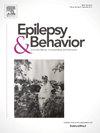解读儿童癫痫的抗癫痫药物依从性:对临床实践和患者护理的意义。
IF 2.3
3区 医学
Q2 BEHAVIORAL SCIENCES
引用次数: 0
摘要
目的:不坚持服用抗癫痫药物(ASM)是癫痫控制不佳的一个常见且可改变的风险因素,会导致住院率增加、疗效评估偏差以及临床决策不准确。本研究旨在估算癫痫患儿不坚持服用抗癫痫药物的比例,并确定导致不坚持服用抗癫痫药物的临床和人口学因素:研究对象包括在印度喀拉拉邦蒂鲁瓦南塔普拉姆政府医学院儿科神经学手术室就诊的至少服用了三个月抗癫痫药物的18岁以下癫痫患者。研究人员使用 "用药依从性报告量表 "问卷对患者自我报告的抗癫痫药物依从性进行了测量。使用 "对药物的信念 "问卷评估对药物的看法,分析临床人口学因素和用药信念,研究它们与参与研究儿童不坚持用药的关系:癫痫儿童的不依从率为 32%。68%的研究对象有较高的必要性信念,60%的研究对象有较低的担忧信念,这表明他们对药物的总体看法是积极的。单变量分析表明,以下因素与 ASM 不依从性密切相关:ASM 副作用(OR:3.01;95% CI:1.52-5.92;P 结论:对药物的看法与不坚持用药有重要的潜在关联。应根据每位患者的具体情况采取干预措施,包括针对患者和家属的特定观念以及药物副作用等实际障碍的措施,以提高患者的用药依从性。本文章由计算机程序翻译,如有差异,请以英文原文为准。
Unraveling Antiseizure Medication Adherence in Paediatric Epilepsy: Implications for Clinical Practice and Patient Care
Objective
Non adherence to antiseizure medications (ASM) is a common and modifiable risk factor for poor control of epilepsy and contributes to increased hospitalizations, bias in assessing the effectiveness of therapy and inaccurate clinical decision making.The aim of the study was to estimate proportion of nonadherence to antiseizure medications among children with epilepsy and to identify clinical and demographic factors that contribute to antiseizure medication non adherence.
Methods
Consecutive subjects ≤ 18 years with epilepsy, on antiseizure medications for atleast three months, attending Pediatric Neurology OPD, Government Medical College Thiruvananthapuram, Kerala, India were included in the study. Self reported adherence to antiseizure medications was measured using Medication Adherence Report Scale questionnaire. Perceptions towards medications were assessed using Beliefs about Medicines Questionnaire Clinicodemographic factors and medication beliefs were analysed to examine their association with non-adherence in the participating children.
Results
The rate of non-adherence in children with epilepsy was 32%. 68% of the study population had high necessity beliefs and 60% showed low concern beliefs, which indicated overall positive perception towards medications. Univariate analysis showed that the following were significantly associated with ASM non adherence: ASM side effects (OR:3.01; 95% CI:1.52–5.92; p < 0.001) and ASM Concerns (OR: 0.84; 95% CI: 0.77–0.92; p 0.0003) and Necessity-Concern Differential Score (OR: 1.19; 95% CI: 1.10–1.29; p 0.0001). Other clinic-demographic variables did not exhibit a significant association with adherence. Multivariate analysis showed that both ASM side effects and ASM beliefs, represented by NCD score remained significant.
Conclusion
Perceptions towards medications have an important and potentially modifiable association with medication non adherence. Interventions to improve adherence should be tailored to each patient, including measures to address the specific beliefs of the patient and the family, along with practical barriers such as side effects of medications.
求助全文
通过发布文献求助,成功后即可免费获取论文全文。
去求助
来源期刊

Epilepsy & Behavior
医学-行为科学
CiteScore
5.40
自引率
15.40%
发文量
385
审稿时长
43 days
期刊介绍:
Epilepsy & Behavior is the fastest-growing international journal uniquely devoted to the rapid dissemination of the most current information available on the behavioral aspects of seizures and epilepsy.
Epilepsy & Behavior presents original peer-reviewed articles based on laboratory and clinical research. Topics are drawn from a variety of fields, including clinical neurology, neurosurgery, neuropsychiatry, neuropsychology, neurophysiology, neuropharmacology, and neuroimaging.
From September 2012 Epilepsy & Behavior stopped accepting Case Reports for publication in the journal. From this date authors who submit to Epilepsy & Behavior will be offered a transfer or asked to resubmit their Case Reports to its new sister journal, Epilepsy & Behavior Case Reports.
 求助内容:
求助内容: 应助结果提醒方式:
应助结果提醒方式:


